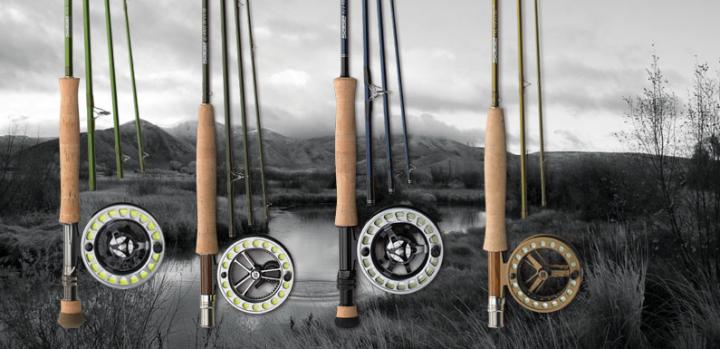How To Select A Fly Rod
By: Bill Bernhardt

The first thing you should understand about fly rods is that they are available in different lengths generally ranging in length from 6 ½ ft. to 14 ft. and each rod length is designed to meet the needs of a specific purpose. The second thing you need to understand about fly rods is that each fly rod is designed to cast a specific weight fly line. Third, you need to be aware that some fly rods are designed specifically for freshwater use and some fly rods are designed specifically for saltwater use.
So, first let’s discuss fly rod length. The reason that there is such a large variation in the length of fly rods is that the length of a fly rod affects the range of distances over which it will cast. Therefore, short fly rods are designed to cast over short ranges and long fly rods are designed to cast over long ranges. Consequently, when you are fishing a small, backcountry, trout stream where short range casts and pinpoint accuracy are the order of the day, then a fly rod ranging in length from 6 ½ ft. to 8 ½ ft. is the most common choice depending on the ranges over which you intend to be casting. However, when you are fly fishing on larger creeks, small rivers, ponds, or lakes, a rod ranging from 9 ft. to 10 ft. is the most common choice. But, when you are fishing medium sized rivers to really large rivers, then a rod ranging from 11 ft. to 14 ft. is the most common length because it will allow you to cast a fly line over a very long distance. In addition, it should be noted that modern fly rods ranging from 11 ft. to 12 ft. in length are often designed with a special grip that allows them to be cast with either one hand or two and thus, they are called “switch” rods because they allow the angler to switch between one-handed and two-handed casting techniques at will. On the other hand, fly rods ranging in length from 13 ft. to 15 ft. are specifically designed to be cast with two hands using special casting techniques known as “spey casting” and thus, these extra long fly rods are known as “spey rods”.
Next, it is important to understand that fly lines are different from conventional fishing lines in that they consist of a braided Dacron core coated with a tapered plastic coating that is impregnated with either glass microbubbles (floating lines) or tungsten powder (sinking lines) in addition to a lubricant. Therefore, fly lines are rated on a scale from 1 to 14 depending on the weight of the first thirty feet of the line with one being the lightest and 14 being the heaviest. Consequently, each fly rod is designed to cast a specific weight fly line because heavier fly lines require a stiffer fly rod to be able to carry their weight and lighter fly lines require a more limber one to cast them. Thus, a fly rod that is designed to cast a 1 wt. fly line does not need to be nearly as stiff as a fly rod designed to cast a 14 wt. fly line and therefore, as a general rule, the lighter the fly line is, the lighter the fly rod designed to cast it will be and, vice versa. Of course, the reason that this is important is that lighter fly rods are less fatiguing to cast than heavy fly rods are and thus, most fly anglers prefer light rods over heavy rods.
In addition, it is also important to understand that some fly rods are designed specifically for freshwater use and some fly rods are designed specifically for saltwater use and, the reason for this is that saltwater fly rods are generally designed to cast larger flies and fight and land larger fish species than freshwater fly rods are (with some exceptions). Thus, freshwater water fly rods are generally designed to cast fly line weights 1 through 6 (again with some exceptions) and salt water fly rods are all designed to cast fly line weights 6 through 14. In addition, while the most common freshwater fly rod length is 8 ½ ft. with 9 ft. rods running a close second, the most common saltwater fly rod length is 9 ft. with some being as short as 8 ½ ft. and some being as long as 10 ft. Also, since saltwater is far more corrosive than fresh water, fly rods designed specifically for saltwater use incorporate guides and reel seats that are made from more corrosion resistant metals and/or coatings than fly rods designed specifically for freshwater use.
Last, it is important to understand that fly rods are also designed to have different types of “actions” or “flex index ratings” and these actions are generally divided into three different categories consisting of slow actions, medium actions, and fast actions. In addition, slow action fly rods are specifically designed to cast over short ranges whereas, medium action fly rods are specifically designed to cast over medium ranges and, fast action fly rods are specifically designed to cast over long ranges. Now, the reason for this is that when a fly rod is bent during casting, the act of bending of the rod stores kinetic energy in the rod and this storing of energy is called “loading”. Then, when said stored energy is released during casting, that energy causes the fly line (and the attached fly leader and fly) to soar out over the water toward your intended target. Thus, slow action fly rods are chosen when fishing at close ranges because, when making short range casts, there is very little fly line (and thus very little weight) out past the top guide to “load” the rod. However, fast action fly rods are generally chosen when casting over long ranges because there is much more line out past the top guide to “load” the fly rod. Therefore, medium action fly rods are designed to fill the gap between slow action and fast action rods and they are chosen when the angler needs a combination of short rang “loadability” and long range power for casting over both shorter and longer ranges.
Therefore, understanding how fly rod length, fly rod action, and fly line weight all work together to create a fly casting system is imperative to enabling you to choose the proper fly rod for any given purpose. Also, it is imperative that you also understand that the lighter a fly line is, the lighter it will land on the water and thus, lighter lines are said to have more delicate presentations. Whereas, although heavier fly lines land more heavily on the water, they will also cast larger, more wind resistant, flies and thus, they are chosen for fishing for larger fish species. Consequently, it is important to choose your rods line weight as well as its action according to the particular purpose that you have in mind for it.
Written by,
Bill Bernhardt
Professional Fly Fishing Guide & Instructor
